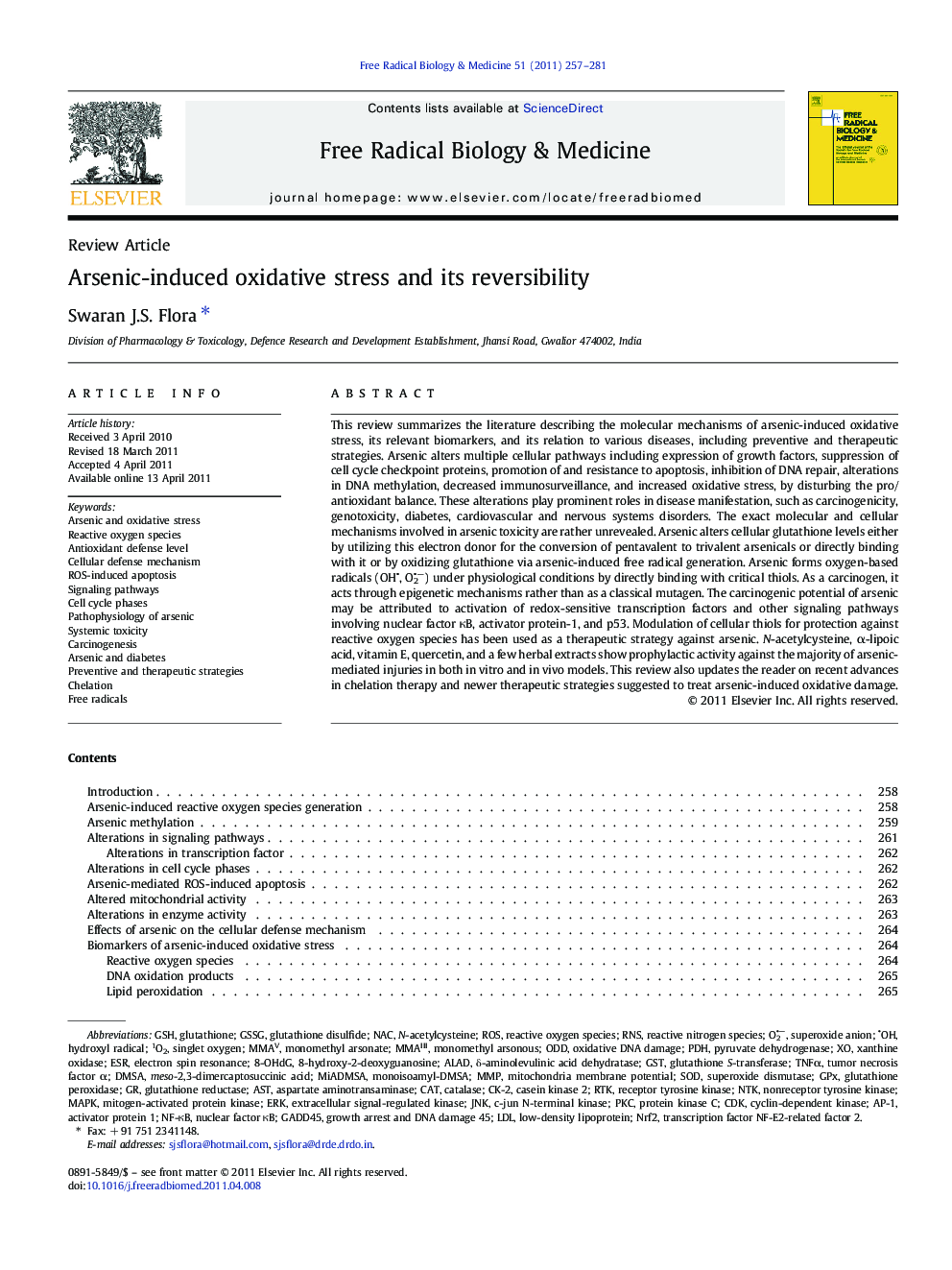| کد مقاله | کد نشریه | سال انتشار | مقاله انگلیسی | نسخه تمام متن |
|---|---|---|---|---|
| 10738061 | 1046682 | 2011 | 25 صفحه PDF | دانلود رایگان |
عنوان انگلیسی مقاله ISI
Arsenic-induced oxidative stress and its reversibility
دانلود مقاله + سفارش ترجمه
دانلود مقاله ISI انگلیسی
رایگان برای ایرانیان
کلمات کلیدی
CK-2Nrf2MiADMSAGSHGSTNACMMAVGPX1O2ERKNF-κBGSSG8-OHdGRNSAP-1PDHPKCGadd45RTKDMSAnonreceptor tyrosine kinaseMMPCATCDKCell cycle phasesMMAIIITNFαJnkESRXanthine oxidase - زانتین اکسیداز8-Hydroxy-2-deoxyguanosine - 8-هیدروکسی-2-دگزسی گوانوزینc-Jun N-terminal kinase - C-Jun N-terminal kinaseMAPK - MAPKN-acetylcysteine - N-استیل سیستئینO2•− - O2 • -ROS - ROSδ-aminolevulinic acid dehydratase - δ-آمینولولولین اسید دهیدراتازAspartate aminotransaminase - آسپارتات آمینوترانسامینازAST - آسپارتات ترانس آمینازOxidative DNA damage - آسیب اکسیداتیو DNAsuperoxide anion - آنیون سوپر اکسیدmeso-2,3-dimercaptosuccinic acid - اسید مازو-2،3-dimercaptosuccinicChelation - اکسیداسیونSinglet oxygen - اکسیژن مجزاtumor necrosis factor α - تومور نکروز عامل αFree radicals - رادیکال آزادHydroxyl radical - رادیکال هیدروکسیلElectron spin resonance - رزونانس اسپین الکترونSOD - سدCarcinogenesis - سرطانزاییSystemic toxicity - سمیت سیستمیکSuperoxide dismutase - سوکسوکس دیسموتازnuclear factor κB - فاکتور هسته ای κBODD - فردLow-density lipoprotein - لیپوپروتئین کم چگالی یا الدیال LDL - لیپوپروتئین کم چگالی(کلسترول بد)Signaling pathways - مسیرهای سیگنالینگALAD - مناطقMitochondria membrane potential - پتانسیل غشای میتوکندریاactivator protein 1 - پروتئین فعال کننده 1Protein kinase C - پروتئین کیناز سیmitogen-activated protein kinase - پروتئین کیناز فعال با mitogenpyruvate dehydrogenase - پیرووات دهیدروژنازCatalase - کاتالازCasein kinase 2 - کازئین کیناز 2extracellular signal-regulated kinase - کیناز تنظیم شده سیگنال خارج سلولیcyclin-dependent kinase - کییناز وابسته به سیکلینGlutathione - گلوتاتیونglutathione S-transferase - گلوتاتیون S-ترانسفرازglutathione disulfide - گلوتاتیون دی سولفیدglutathione reductase - گلوتاتیون ردوکتازglutathione peroxidase - گلوتاتیون پراکسیدازreactive nitrogen species - گونه های واکنش پذیر نیتروژنReactive oxygen species - گونههای فعال اکسیژنReceptor Tyrosine Kinase - گیرنده تیروزین کیناز•OH - • OH
موضوعات مرتبط
علوم زیستی و بیوفناوری
بیوشیمی، ژنتیک و زیست شناسی مولکولی
سالمندی
پیش نمایش صفحه اول مقاله

چکیده انگلیسی
This review summarizes the literature describing the molecular mechanisms of arsenic-induced oxidative stress, its relevant biomarkers, and its relation to various diseases, including preventive and therapeutic strategies. Arsenic alters multiple cellular pathways including expression of growth factors, suppression of cell cycle checkpoint proteins, promotion of and resistance to apoptosis, inhibition of DNA repair, alterations in DNA methylation, decreased immunosurveillance, and increased oxidative stress, by disturbing the pro/antioxidant balance. These alterations play prominent roles in disease manifestation, such as carcinogenicity, genotoxicity, diabetes, cardiovascular and nervous systems disorders. The exact molecular and cellular mechanisms involved in arsenic toxicity are rather unrevealed. Arsenic alters cellular glutathione levels either by utilizing this electron donor for the conversion of pentavalent to trivalent arsenicals or directly binding with it or by oxidizing glutathione via arsenic-induced free radical generation. Arsenic forms oxygen-based radicals (OH
- , O2
- â) under physiological conditions by directly binding with critical thiols. As a carcinogen, it acts through epigenetic mechanisms rather than as a classical mutagen. The carcinogenic potential of arsenic may be attributed to activation of redox-sensitive transcription factors and other signaling pathways involving nuclear factor κB, activator protein-1, and p53. Modulation of cellular thiols for protection against reactive oxygen species has been used as a therapeutic strategy against arsenic. N-acetylcysteine, α-lipoic acid, vitamin E, quercetin, and a few herbal extracts show prophylactic activity against the majority of arsenic-mediated injuries in both in vitro and in vivo models. This review also updates the reader on recent advances in chelation therapy and newer therapeutic strategies suggested to treat arsenic-induced oxidative damage.
- , O2
- â) under physiological conditions by directly binding with critical thiols. As a carcinogen, it acts through epigenetic mechanisms rather than as a classical mutagen. The carcinogenic potential of arsenic may be attributed to activation of redox-sensitive transcription factors and other signaling pathways involving nuclear factor κB, activator protein-1, and p53. Modulation of cellular thiols for protection against reactive oxygen species has been used as a therapeutic strategy against arsenic. N-acetylcysteine, α-lipoic acid, vitamin E, quercetin, and a few herbal extracts show prophylactic activity against the majority of arsenic-mediated injuries in both in vitro and in vivo models. This review also updates the reader on recent advances in chelation therapy and newer therapeutic strategies suggested to treat arsenic-induced oxidative damage.
ناشر
Database: Elsevier - ScienceDirect (ساینس دایرکت)
Journal: Free Radical Biology and Medicine - Volume 51, Issue 2, 15 July 2011, Pages 257-281
Journal: Free Radical Biology and Medicine - Volume 51, Issue 2, 15 July 2011, Pages 257-281
نویسندگان
Swaran J.S. Flora,